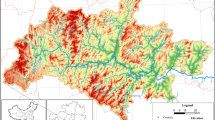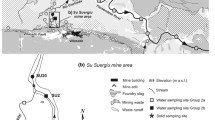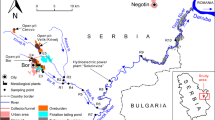Abstract
Antimony (Sb) usually occurs associated with arsenic, lead, and other metal elements in sulfide deposits, and most is currently being extracted from the Karst areas, southwest China. In these areas, the acid generated from the oxidative dissolution of sulfide minerals is neutralized by the abundant carbonates but little is known about the effect of this process on the geochemical behavior of Sb and other contaminants. In this study, physicochemical properties (pH, EC) and the trace elements (Sb, As, Cu, Pb, Zn, Sr, etc.) concentrations in waters from mining-impacted Karstic environments were determined in order to determine their distribution and migration potential. It was found that pH values ranged from 6.51 to 9.82, and EC values varied from 369 to 1705 μs·cm−1 in river water samples. Waters of various types such as adit waters, flotation drainage, leaching waters, and river waters all contained high concentrations of dissolved trace elements, reaching up to 5475 μg·L−1Sb, 1877 μg·L−1As, 10,371 μg·L−1Zn, 1309 μg·L−1 Pb, 46 μg·L−1 Cu, and 1757 μg·L−1 Sr. The elevated concentrations of dissolved Sr indicated that Sr could be considered as an indicator of oxidative dissolution of sulfide minerals in the Karst rivers. A proportion of the trace elements were removed in the streams in the vicinity of the mine due to adsorption onto particulate matter, whereas migration of trace elements in the downstream of mine area was attributed to dispersion in dissolved forms. Strontium and Sb have a strong hydrophilicity compared to the other elements analyzed; in contrast, Pb had a high affinity for suspended particulate matter (SPM). It was also found that downstream sediments had elevated concentrations of mining-derived trace elements, but there was a significant decrease in concentration of contaminants in aqueous phase, suggesting that contaminant behavior was conservative in the water-sediment systems under the oxic conditions prevailing in these waters. There was a good correlation between Sb and As in water-SPM-sediment system, indicating that Sb and As are homologous in water environment of the study area.









Similar content being viewed by others
References
Asaoka S, Takahashi Y, Araki Y, Tanimizu M (2012) Comparison of antimony and arsenic behavior in an Ichinokawa River water-sediment system. Chem Geol 334:1–8
Ashley PM, Craw D, Graham BP, Chappell DA (2003) Environmental mobility of antimony around mesothermal stibnite deposits, New South Wales, Australia and southern New Zealand. J Geochem Explor 77:1–14
Badal KM, Kazuo TS (2002) Arsenic round the world: a review. Talanta 58(1):201–235
Basta NT, Tabatabai MA (1992) Effect of cropping systems on adsorption of metals by soils: II. Effect of pH. Soil Sci 153:195–204
Byrne P, Runkel RL, Walton-Day K (2017) Synoptic sampling and principal components analysis to identify sources of water and metals to an acid mine drainage stream. Environ Sci Pollut Res 24:17220–17240
Casiot C, Ujevic M, Munoz M, Seidel JL, Elbaz-Poulichet F (2007) Antimony and arsenic mobility in a creek draining an antimony mine abandoned 85 years ago (upper Orb basin, France). Appl Geochem 22:788–798
Chuan MC, Shu GY, Liu JC (1996) Solubility of heavy metals in a contaminated soil: effects of redox potential and pH. Water Air Soil Pollut 90(3):543–556
Cidu R, Biddau R (2007) Transport of trace elements at different seasonal conditions: effects on the quality of river water in a Mediterranean area. Appl Geochem 22:2777–2794
Cidu R, Frau F (2009) Influence of the fine-particle load in Mediterranean rivers and streams on the distribution of trace elements in filtered and non filtered aqueous fractions. Appl Geochem 24:611–623
de Matos AT, Fontes MPF, da Costa LM, Martinez MA (2001) Mobility of heavy metals as related to soil chemical and mineralogical characteristics of Brazilian soils. Environ Pollut 111:429–435
Fawcett S, Jamieson H, Nordstrom D, McCleskey R (2015) Arsenic and antimony geochemistry of mine wastes, associated waters and sediments at the Giant Mine, Yellowknife, Northwest Territories, Canada. Appl Geochem 62:3–17
Filella M, Belzile N, Chen Y-W (2002) Antimony in the environment: a review focused on natural waters I. Occurrence. Earth Sci Rev 57:125–176
Flemming CA, Trevors JT (1989) Copper toxicity and chemistry in the environment: a review. Water Air Soil Pollut 44:143–158
Fu Z, Wu F, Mo C-L, Liu B, Zhu J, Deng Q, Liao H, Zhang Y (2011) Bioaccumulation of antimony, arsenic, and mercury in the vicinities of a large antimony mine, China. Microchem J 97:12–19
Grigoratos T, Martini G (2015) Brake wear particle emissions: a review. Environ Sci Pollut Res 22:2491–2504
He H, Yang Z (2007) Application of the prospecting-information method to newly metallogenic prediction in the Dachang ore field, Guangxi. Miner Resour Geology 21:560–562 (in Chinese)
He M, Wang X, Wu F, Fu Z (2012) Antimony pollution in China. Sci Total Environ 421-422:41–50
Herbel M, Fendorf S (2006) Biogeochemical processes controlling the speciation and transport of arsenic within iron coated sands. Chem Geol 228:16–32
Hiller E, Lalinská B, Chovan M, Jurkovič L, Klimko T, Jankulár M, Hovorič R, Šottník P, Fľaková R, Ženišová Z, Ondrejková I (2012) Arsenic and antimony comtamination of waters, stream sediments and soils in the vicinity of abandoned antimony mines in the Western Carpathians, Slovakia. Appl Geochem 27:598–614
Hockmann K, Schulin R (2012) Leaching of Antimony from Contaminated Soils In: Competitive Sorption and Transport of Heavy Metals in Soil and Geological Media. CRC Press, Boca Raton 121
Langner HW, Inskeep WP (2000) Microbial reduction of arsenate in the presence of ferrihydrite. Environ Sci Technol 34:3131–3136
Li X, Thornton I (1993) Arsenic, antimony and bismuth in soil and pasture herbage in some old metalliferous mining areas in England. Environ Geochem Health 15:135–144
Li L, Zhang G, Liu H, Xiang M, Wei X (2009) Antimony and arsenic migration and environmental impacts on river draining in the Dachang multi-metalliferous mine area in Guangxi, China. Res Environ Sci 22:682–687 (in Chinese)
Liu YJ, Cao LM, Li ZL (1984) Element Geochemistry, vol 365. Science in China Press, Beijing (in Chinese)
Liu C-Q et al (2007) Biogeochemistry processes and surface-earth materials cycling—erosion and biological nutrients cycling in Karstic catchments, Southwest China. Science in China Press, Beijing 148 (in Chinese)
Macgregor K, MacKinnon G, Farmer J, Graham M (2015) Mobility of antimony, arsenic and lead at a former antimony mine, Glendinning, Scotland. Sci Total Environ 529:213–222
Manaka M, Yanase N, Sato T, Fukushi K (2007) Natural attenuation of antimony in mine drainage water. Geochem J 41:17–27
Mandal BK, Suzuki KT (2002) Arsenic round the world: a review. Talanta 58:201–235
Mariussen E, Johnsen IV, Strømseng AE (2017) Distribution and mobility of lead (Pb), copper (Cu), zinc (Zn), and antimony (Sb) from ammunition residues on shooting ranges for small arms located on mires. Environ Sci Pollut Res 24:10182–10196
Masscheleyn PH, Delaune RD, Patrick WH (1991) Effect of redox potential and pH on arsenic speciation and solubility in a contaminated soil. Environ Sci Technol 25(8):1414–1419
Masson M, Schäfer J, Blanc G, Dabrin A, Castelle S, Lavaux G (2009) Behavior of arsenic and antimony in the surface freshwater reaches of a highly turbid estuary, the Gironde Estuary, France. Appl Geochem 24(9):1747–1756
Migaszewski ZM, Gałuszka A, Dołęgowska S (2016) Rare earth and trace element signatures for assessing an impact of rock mining and processing on the environment: Wiśniówka case study, south-Central Poland. Environ Sci Pollut Res 23:24943–24959
Milham L, Craw D (2009) Antimony mobilization through two contrasting gold ore processing systems, New Zealand. Mine Water Environ 28(2):136–145
Moore F, Dehbandi R, Keshavarzi B, Amjadian K (2016) Potentially toxic elements in the soil and two indigenous plant species in Dashkasan epithermal gold mining area, West Iran. Environ Earth Sci 75:268
Palmer MR, Edmond JM (1992) Controls over strontium isotope composition of river water. Geochim Cosmochim Acta 56:2099–2111
Qi W, Cao J (1991) Research on the background values of antimony in soils. Chin J Sci 22:209–210 (in Chinese)
Ritchie VJ, Ilgen AG, Mueller SH, Trainor TP, Goldfarb RJ (2013) Mobility and chemical fate of antimony and arsenic in historic mining environments of the Kantishna Hills district, Denali National Park and Preserve, Alaska. Chem Geol 335:172–188
Rzymski P, Klimaszyk P, Marszelewski W, Borowiak D, Mleczek M, Nowiński K, Pius B, Niedzielski P, Poniedziałek B (2017) The chemistry and toxicity of discharge waters from copper mine tailing impoundment in the valley of the Apuseni Mountains in Romania. Environ Sci Pollut Res 24:21445–21458
Sharifi R, Moore F, Keshavarzi B (2016) Mobility and chemical fate of arsenic and antimony in water and sediments of Sarouq River catchment, Takab geothermal field, Northwest Iran. J Environ Manag 170:136–144
Shotyk W, Krachler M, Chen B (2005) Antimony: global environmental contaminant. J Environ Monit 7:1135–1136
Sprague DD, Michel FA, Vermaire JC (2016) The effects of migration on ca. 100-year-old arsenic-rich mine tailings in cobalt, Ontario, Canada. Environ Earth Sci 75:405
Takahashi Y, Minamikawa R, Hattori KH, Kurishima K, Kihou N, Yuita K (2004) Arsenic behavior in paddy fields during the cycle of flooded and non-flooded periods. Environ Sci Technol 38:1038–1044
Tschan M, Robinson B, Schulin R (2009) Antimony in the soil-plant system - a review. Environ Chem 6:106–115
Tu (1988) Searches and studies for Superlarge mineral deposits. Golden Geology 1–2 (in Chinese)
Wang L, Zhang M (2007) Release behaviors of heavy metals from polluted soils with heavy metals of different sources. Res Environ Sci 20:134–138 (in Chinese)
Wang D, Chen Y, Chen W et al (2004) Dating the Dachang Giant tin - polymetallic deposit in Nandan, Guangxi. Acta Geol Sin 78:132–138 (in Chinese)
Wang X, He M, Xi J, Lu X (2011) Antimony distribution and mobility in rivers around the world's largest antimony mine of Xikuangshan, Hunan Province, China. Microchem J 97:4–11
Warren LJ (1981) Contamination of sediments by lead, zinc and cadmium: a review. Environ Pollut Ser B Chem Phys 2:401–436
Yang H, He M, Wang X (2015) Concentration and speciation of antimony and arsenic in soil profiles around the world’s largest antimony metallurgical area in China. Environ Geochem Health 37:21–33
Zhang GP, Liu C-Q, Liu H, Hu J, Han G, Li L (2009) Mobilisation and transport of arsenic and antimony in the adjacent environment of Yata gold mine, Guizhou province, China. J Environ Monit 11:1570–1578
Zhou Y, Song S, Zhang C, Yang X, Liu C (2005) Water environmental geochemical response of rivers to mines and mining activity-a case study of the Diaojiang River drainage system, Guangxi, China. Geol Bull Chin 24:940–944 (in Chinese)
Zhou J, Nyirenda M, Xie L et al (2017) Mine waste acidic potential and distribution of antimony and arsenic in waters of the Xikuangshan mine, China. Appl Geochem 77:52–61
Zhu J, Wu FC, Deng QJ, Shao SX, Mo CL, Pan XL, Li W, Zhang RY (2009) Environmental characteristics of water near the Xikuangshan antimony mine. Acta Sci Circumst 29:655–661 (in Chinese)
Acknowledgements
This work was supported by the National Natural Science Foundation of China (No.41401568). The authors would like to acknowledge Dr. Margaret Graham, a reader in University of Edinburgh, for her instructive suggestions and valuable comments on the writing of this paper.
Author information
Authors and Affiliations
Corresponding author
Additional information
Responsible editor: Severine Le Faucheur
Rights and permissions
About this article
Cite this article
Li, L., Liu, H. & Li, H. Distribution and migration of antimony and other trace elements in a Karstic river system, Southwest China. Environ Sci Pollut Res 25, 28061–28074 (2018). https://doi.org/10.1007/s11356-018-2837-x
Received:
Accepted:
Published:
Issue Date:
DOI: https://doi.org/10.1007/s11356-018-2837-x




